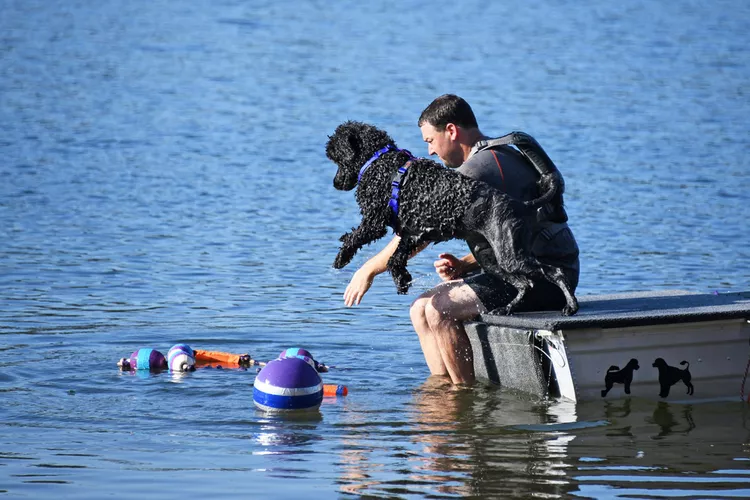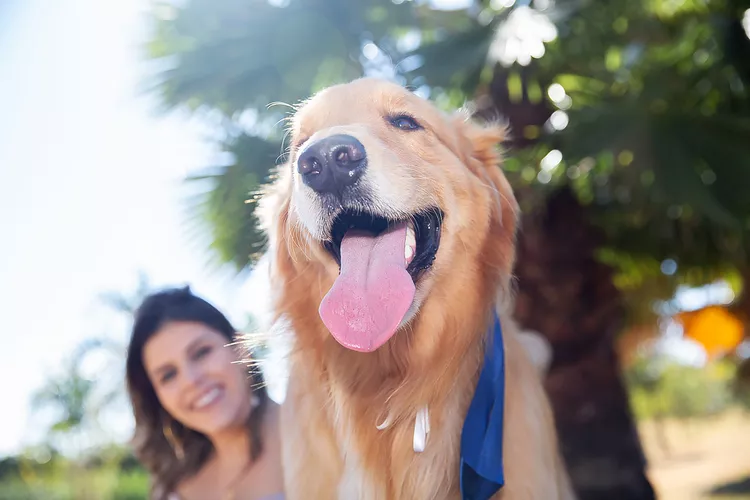3 Important Factors to Think About Before Boating with Your Dog
Sharing your favorite pastime with your pooch can make for fun summer days with some practice and safety top-of-mind.
Colleen Bragg, owner of Endless Pawsabilities in Hurricane, W. Va., often has her Portuguese water dogs competing at Water Work events, where they hop in the water and carry equipment from one boat to another or do underwater retrieval and other activities. Sure, Portuguese water dogs are known for loving the water, but many dogs can learn to love boating.
If you’re looking to take your dog boating with you next time you venture out on the water, there are a few things to consider to make sure it’s a fun, safe experience for both you and your pup.
– Dog Boating Supplies and Safety Gear You’ll Need to Get Started
– Life jacket
– Dog first aid kit
– Water and food bowls
– Treats
– Toys
– Dog sunscreen
– Floatable leash
– Non-slip mat (helpful on fiberglass boat)
– Towels
– Wee-wee pads or Astroturf

How to Train Your Dog to Get On and Off a Boat
Getting from the dock onto the boat can be the most dangerous time as the boat may be moving, and your dog may be fearful. Depending on the dog, you may find it is safest to carry your dog on and off a boat, always check-in with them to make sure they want to go for a boat ride and are comfortable with the experience. If your dog is large you’ll need to spend some time teaching them how to get on board on slowly and safely.
Keep in mind the kind of boat you’re getting into. Most of the following discussion will be about motorboats. You don’t want to bring your dog on a boat that’s prone to tipping, like a small sailboat.
Start off by getting your dog exposed to boats, in general. “Bring your dog to a marina and let them get used to the sound of the boat motor,” Bragg says. To get them onto the boat itself, toss some treats from the dock onto the boat. If you’ve previously taught your dog a cue for “find,” play a game in which your dog has to search for their treat. Make it fun. Spending ample time teaching your dog that boats are fun, and making sure your dog feels safe around them, is crucial.
If your dog won’t just jump on board, you might purchase a ramp or ramp/ladder combo specifically made for helping your dog get safely into and out of the boat.
And, once they’re on board, keep it fun with more treats and lots of positive reinforcement.

3 Tips to Safely Boat With Your Dog
1. Go at your dog’s pace.
Bragg started boating with her dogs when they were pups and “it only took a couple of times to get them comfortable,” she says. “But for an older dog it might take an entire summer.”
If your dog’s fearful or anxious, you’ll scare them bydragging them onto the boat or trying to “push through their anxiety,” Bragg says. Some signs of anxiety are excessive panting, refusal to approach or get on the boat, rigid stillness, excessive yawning, lip licking, and whale eye (where you can see the whites of your dog’s eyes when you usually can’t).
“It can have disastrous consequences,” she says. Your dog might develop boat anxiety and try to get off or away from the boat—jumping into the water, refusing to get back on the boat to head back to the dock, or trying to get to land.
You may discover that your dog just isn’t a fan of boating or doesn’t enjoy being on the boat for very long. That’s OK! Not every dog is going to be an avid boater.
The bottom line is, be patient and follow your dog’s lead, and never force your dog to do something they don’t enjoy.
2. Keep your dog on board.
Regardless of the type of boat you’re on, find a spot in which your dog feels comfy and let them know it belongs to him or her. If it’s on the deck, position a non-slip mat covered in a towel. Lots of treats can help your dog understand that this is their spot. If you practice “stationing behavior” (having a place to go to) on land, Bragg says, the same cues can transfer to the boat.
3. Make safety the first priority.
Safety should be the number one priority when boating with your dog. “Small dogs are at greater risk of being thrown from a boat if you’re going to fast in choppy waters,” Bragg says.
And, even if your dog loves to swim, it’s a good idea to put them in a life jacket. Bragg recommends the Ruffwear float coat. “They’re durable, last forever, fit dogs well, and they have a secure integrated handle, which makes it easier to pull your dog back into the boat.”
You’ll know it fits if you can get a couple of fingers beneath the strap. Get your dog into the life jacket as soon as you board. If your dog falls overboard, suddenly jumps off the boat, or there is an accident it would be too late to put the float coat on the dog.
You might also take along a floating leash especially if your dog doesn’t have a good stay or a good recall. “Floating leashes are less likely to get caught on something under the water surface, or in a boat propeller,” Bragg says. “They are also easier to grab onto if needed.”
Also, keep your pup hydrated with fresh water, and, if they’ve got a pink nose or naked ear tips, slather on a bit of sunscreen specifically for dogs.
Paws to Consider
We go boating because it’s fun, and we want to take our dogs with us because we love them and enjoy their company. But if your dog gets car sickness or gets anxious on car rides, they may not enjoy boating since boating involves more of the same motion that causes car sickness.
“If your dog is truly unhappy when boating, the safest thing to do is to leave Fido at home,” Bragg says.











Post Comment